As temperatures rise, finding an effective cooling solution becomes a top priority for many homeowners and renters. While central air conditioning and window units have long been popular, portable air conditioners (PACs) have gained significant attention due to their versatility, ease of installation, and mobility. These units promise to provide relief from the heat without the hassle of permanent installation, making them an attractive option for people living in apartments, rental homes, or spaces where traditional AC options aren’t feasible.
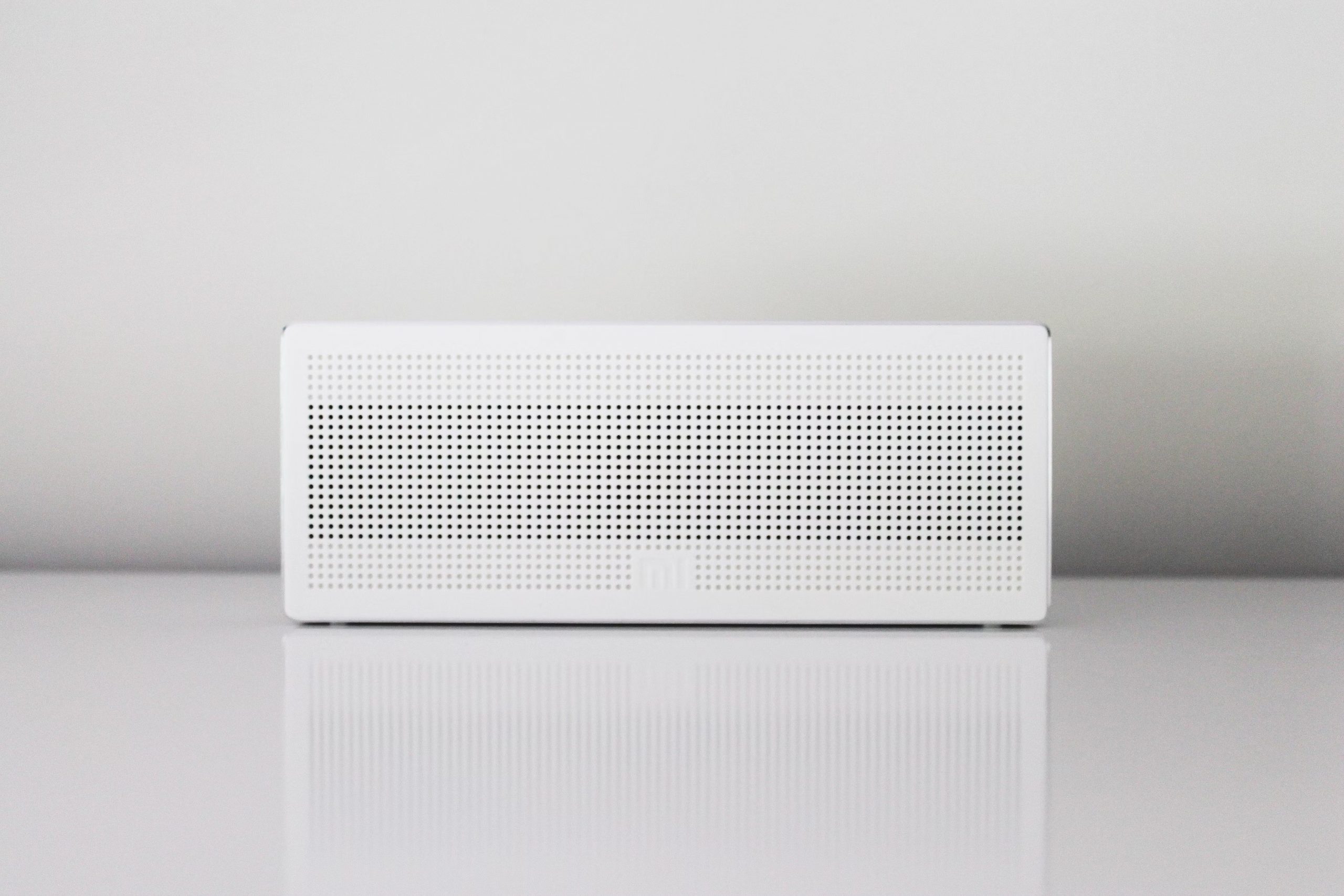
However, how effective are portable air conditioners really? Do they provide sufficient cooling power, or are they simply an overpriced fan? In this article, we’ll explore their efficiency, compare them to other cooling methods, highlight key features to look for, and provide tips on maximizing their performance.
Efficiency Comparison: Portable vs. Window Units
When choosing between a portable air conditioner and a window AC unit, efficiency is a key factor. The effectiveness of an air conditioner depends on how well it cools a room, energy consumption, heat exhaust, and overall performance. Below, we break down each of these aspects to help you make an informed decision.
1. Cooling Performance
The primary function of an air conditioner is to cool a room effectively, and different types of ACs have varying levels of cooling power.
BTU Ratings and Cooling Area
The British Thermal Unit (BTU) rating of an air conditioner determines its cooling capacity. Although portable and window units may have similar BTU ratings, window ACs tend to cool more efficiently.
| BTU Rating | Cooling Area (Portable AC) | Cooling Area (Window AC) |
|---|---|---|
| 8,000 BTU | Up to 200 sq. ft. | Up to 350 sq. ft. |
| 10,000 BTU | Up to 300 sq. ft. | Up to 450 sq. ft. |
| 12,000 BTU | Up to 400 sq. ft. | Up to 550 sq. ft. |
| 14,000 BTU | Up to 500 sq. ft. | Up to 700 sq. ft. |
- Portable ACs lose some cooling power due to their design. The heat exhaust system and single-hose models can create negative pressure, pulling warm air back into the room.
- Window units are mounted in a window with their exhaust and compressor outside, preventing heat from re-entering.
Heat Exhaust and Cooling Efficiency
One of the main reasons window ACs perform better than portable ACs is how they expel heat:
-
Portable ACs: Use a flexible exhaust hose that is vented out a window, door, or another opening.
- Single-Hose Design: Draws warm air from the room, cools it, and then expels hot air outside. However, this can create negative pressure, causing hot air from other parts of the house to be pulled in, reducing efficiency.
- Dual-Hose Design: One hose draws air from outside, and the other expels hot air, making it more efficient than single-hose models but still not as efficient as window ACs.
-
Window ACs: Expel all heat directly outside, eliminating heat recirculation issues and ensuring that the unit works at full efficiency.
Air Circulation and Temperature Control
- Portable ACs struggle to distribute cold air evenly across a large space** due to their placement on the floor. Cool air naturally sinks, making it harder for these units to spread cold air throughout the room.
- Window ACs are mounted higher up, allowing better circulation and more uniform temperature distribution.
Winner: Window ACs – They provide stronger and more effective cooling, especially for larger rooms.
2. Energy Consumption and Efficiency
The energy efficiency of an air conditioner is measured by its Energy Efficiency Ratio (EER) and Seasonal Energy Efficiency Ratio (SEER).
- EER: Measures how much cooling (BTUs) an air conditioner provides per watt of electricity consumed. The higher the EER rating, the more efficient the unit.
- SEER: Measures the efficiency over an entire cooling season, accounting for variations in temperature and humidity.
Average EER Ratings Comparison
| Type of AC | Average EER Rating | Power Consumption (Per Hour) |
|---|---|---|
| Portable AC | 7 – 10 | 900 – 1,500 watts |
| Window AC | 10 – 12 | 500 – 1,200 watts |
- Window ACs generally have higher EER ratings because they operate in a more controlled environment and don’t have to compensate for heat leaks and inefficient exhaust systems.
- Portable ACs require more energy to provide the same cooling effect due to heat loss through exhaust hoses and negative pressure issues.
Energy Star Certification
Many window ACs are Energy Star certified, meaning they meet higher efficiency standards set by the U.S. Department of Energy. Portable ACs rarely meet these criteria due to their lower efficiency.
Winner: Window ACs – They consume less electricity while providing better cooling performance.
3. Installation and Portability
While window ACs are more efficient, they may not always be the most convenient option. Let’s compare installation requirements and portability.
Installation
- Window ACs: Require mounting in a window or a permanent opening in the wall. While this installation is straightforward, it’s not ideal for renters or those who cannot alter their living space.
- Portable ACs: Are easier to install since they only need a window or door for venting. They are a better choice for those in apartments, dorms, or rental properties where modifying windows isn’t allowed.
Portability
- Portable ACs are easy to move from room to room. If you need cooling in multiple areas, this flexibility can be an advantage.
- Window ACs remain fixed, making them less versatile but more effective.
Winner: Portable ACs – They are easier to install and move around, making them the better choice for those needing flexibility.
4. Noise Levels
Noise levels are an important factor, especially for bedrooms, home offices, or living rooms.
| AC Type | Average Noise Level (Decibels, dB) |
|---|---|
| Portable AC | 50 – 65 dB |
| Window AC | 45 – 55 dB |
- Portable ACs are noisier because the compressor and fan are inside the room. Even with noise-reducing technology, most models operate at around 50-65 dB, similar to background conversation noise.
- Window ACs are quieter because the noisy components are outside, reducing the indoor sound level.
Which One is Better for Noise?
If you prefer a quieter environment, window ACs are the better option.
Winner: Window ACs – They operate more quietly since the compressor is outside the room.
5. Cost Considerations
The initial cost and long-term operating cost are important factors when choosing an AC.
Initial Cost
- Portable ACs: Typically cost $250 – $600, depending on BTU capacity and features.
- Window ACs: Typically cost $150 – $500, making them more affordable upfront.
Long-Term Cost (Electricity Bills & Maintenance)
- Portable ACs: Higher power consumption = higher electricity bills.
- Window ACs: More efficient = lower electricity costs over time.
Durability and Lifespan
- Portable ACs generally last 5-8 years with proper maintenance.
- Window ACs can last 10-15 years, making them a better long-term investment.
Winner: Window ACs – They have lower costs over time and last longer.
Which One is More Efficient?
| Category | Winner |
|---|---|
| Cooling Power | Window AC |
| Energy Efficiency | Window AC |
| Installation & Portability | Portable AC |
| Noise Levels | Window AC |
| Cost Over Time | Window AC |
Who Should Buy a Portable AC?
✅ Ideal for renters or people who can’t install a window unit.
✅ Great for those needing mobility to cool different rooms.
✅ Best for small spaces where window installation is not an option.
Who Should Buy a Window AC?
✅ Better for cooling large areas efficiently.
✅ Ideal for those who prioritize energy savings.
✅ Best for long-term use due to durability and lower operating costs.
Overall Winner: Window ACs for Efficiency, Portable ACs for Flexibility
If energy efficiency and cooling power are your top priorities, a window AC is the better choice. However, if portability and easy installation matter most, then a portable AC is a convenient alternative.
Features to Consider When Buying a Portable AC
Choosing the right portable air conditioner (PAC) can make a huge difference in cooling efficiency, energy savings, and overall user experience. Below are the most critical factors to consider before purchasing a portable AC.
1. BTU Rating: Choosing the Right Cooling Capacity
The British Thermal Unit (BTU) rating determines the cooling power of an air conditioner. Selecting the right BTU capacity is crucial because:
- Too Low – The AC will struggle to cool the room, running constantly and increasing energy costs.
- Too High – It will cycle on and off too frequently, leading to inefficient cooling and excess humidity.
BTU Recommendations Based on Room Size
| BTU Rating | Recommended Room Size |
|---|---|
| 8,000 BTU | Up to 200 sq. ft. (small bedrooms, offices) |
| 10,000 BTU | Up to 300 sq. ft. (medium-sized bedrooms, small living rooms) |
| 12,000 BTU | Up to 400 sq. ft. (larger rooms, studio apartments) |
| 14,000 BTU | Up to 500 sq. ft. (large open spaces, big living rooms) |
Factors Affecting BTU Needs
- Ceiling Height: If your room has high ceilings (10+ feet), increase the BTU rating by 10-20%.
- Sun Exposure: If the room gets a lot of direct sunlight, increase the BTU rating by 10%.
- Number of Occupants: If more than two people regularly use the room, add 600 BTUs per additional person.
- Electronics & Appliances: Rooms with many devices (e.g., computers, TVs) generate extra heat and may need a higher BTU AC.
2. Single-Hose vs. Dual-Hose Design
Portable ACs come in single-hose and dual-hose designs, which impact efficiency and performance.
Single-Hose Portable ACs
✅ Pros:
- Lower cost – Generally cheaper than dual-hose models.
- Easier to install – Only one hose to vent outside.
❌ Cons:
- Less efficient – Pulls air from inside the room, cooling it but also creating negative pressure that pulls in warm air from outside.
- Slower cooling – Because of heat recirculation, it takes longer to reach desired temperatures.
Dual-Hose Portable ACs
✅ Pros:
- More efficient cooling – One hose pulls in fresh air, the other expels hot air, improving cooling efficiency.
- Less heat leakage – Reduces negative pressure and prevents warm air from entering the room.
❌ Cons:
- Higher price – Typically more expensive.
- More complex installation – Requires space for two hoses.
Best Choice: If energy efficiency is a priority, go for a dual-hose model. However, if you need a budget-friendly option, a single-hose AC can still work effectively in small spaces.
3. Energy Efficiency and Power Consumption
Portable ACs consume a significant amount of energy, so looking at efficiency ratings can help you save on electricity bills.
Energy Efficiency Ratio (EER) & Seasonal Energy Efficiency Ratio (SEER)
- EER (Energy Efficiency Ratio): Measures cooling efficiency based on BTU per watt of power consumed. Higher EER = more efficiency.
- Good EER rating: Above 10
- SEER (Seasonal Energy Efficiency Ratio): Measures long-term efficiency over a cooling season.
Look for Energy-Saving Features
- Energy Star Certification – Indicates high energy efficiency.
- Eco Mode – Adjusts cooling settings to reduce power consumption.
- Programmable Timer – Allows you to set specific operating times to avoid unnecessary energy use.
- Smart Thermostat – Adjusts cooling based on room temperature for automatic energy savings.
4. Noise Levels: How Loud is Too Loud?
Portable air conditioners can be noisy, so checking the decibel (dB) rating is essential if you plan to use it in a bedroom, home office, or living room.
Average Noise Levels for Portable ACs
| Noise Level (dB) | Comparable Sound | Best For |
|---|---|---|
| 40 – 50 dB | Library, quiet home | Bedrooms, offices |
| 50 – 60 dB | Normal conversation | Living rooms |
| 60 – 70 dB | Loud dishwasher | Large rooms, garages |
- Quieter Models: Look for units with “sleep mode” or sound insulation features to minimize noise.
- Dual-Hose Units: These tend to be slightly quieter than single-hose models due to better efficiency.
5. Additional Features for Convenience
Portable ACs come with a variety of extra features that can enhance usability and performance.
Smart Features & Remote Control
- Wi-Fi Enabled ACs allow you to control temperature settings from your smartphone. Great for adjusting cooling before you get home!
- Voice Control Integration – Some models work with Amazon Alexa or Google Assistant for hands-free operation.
Dehumidifier Mode
- Many portable ACs include a built-in dehumidifier, which removes excess moisture from the air.
- This is especially useful in humid climates where humidity makes the heat feel worse.
Auto-Evaporation & Drainage System
- Auto-evaporation models eliminate the need for draining water, making maintenance easier.
- Models without auto-evaporation require manual drainage, especially in humid areas.
Adjustable Fan Speeds & Airflow Direction
- Multiple fan speed settings allow better control over cooling intensity.
- Oscillating vents help distribute air more evenly across the room.
6. Portability & Design Considerations
Since portability is a key selling point, make sure the unit is easy to move between rooms.
✅ Things to Look For:
- Caster Wheels – Makes rolling the AC unit around easier.
- Lightweight Design – Some models are heavier than others; check weight before buying.
- Compact Size – If space is limited, smaller models might be a better fit.
Final Buying Tips: How to Choose the Best Portable AC
✅ Choose the Right BTU – Match it to your room size for optimal cooling.
✅ Pick Dual-Hose Over Single-Hose – If possible, for better efficiency.
✅ Look for Energy Star Certification – Saves money in the long run.
✅ Check the Noise Level – If using in a bedroom, get a quiet model.
✅ Smart Features Are a Plus – Wi-Fi and remote control offer convenience.
✅ Consider a Built-in Dehumidifier – Useful for humid climates.
By keeping these features in mind, you can choose the best portable air conditioner that fits your needs, budget, and lifestyle.
Recommended Portable Air Conditioners
When selecting a portable air conditioner, it’s important to choose a model that balances cooling power, energy efficiency, noise level, and additional features. Below are some of the best-rated portable ACs in 2025, categorized based on different needs and budgets.
#1. Whynter ARC-14S – Best Overall Portable AC
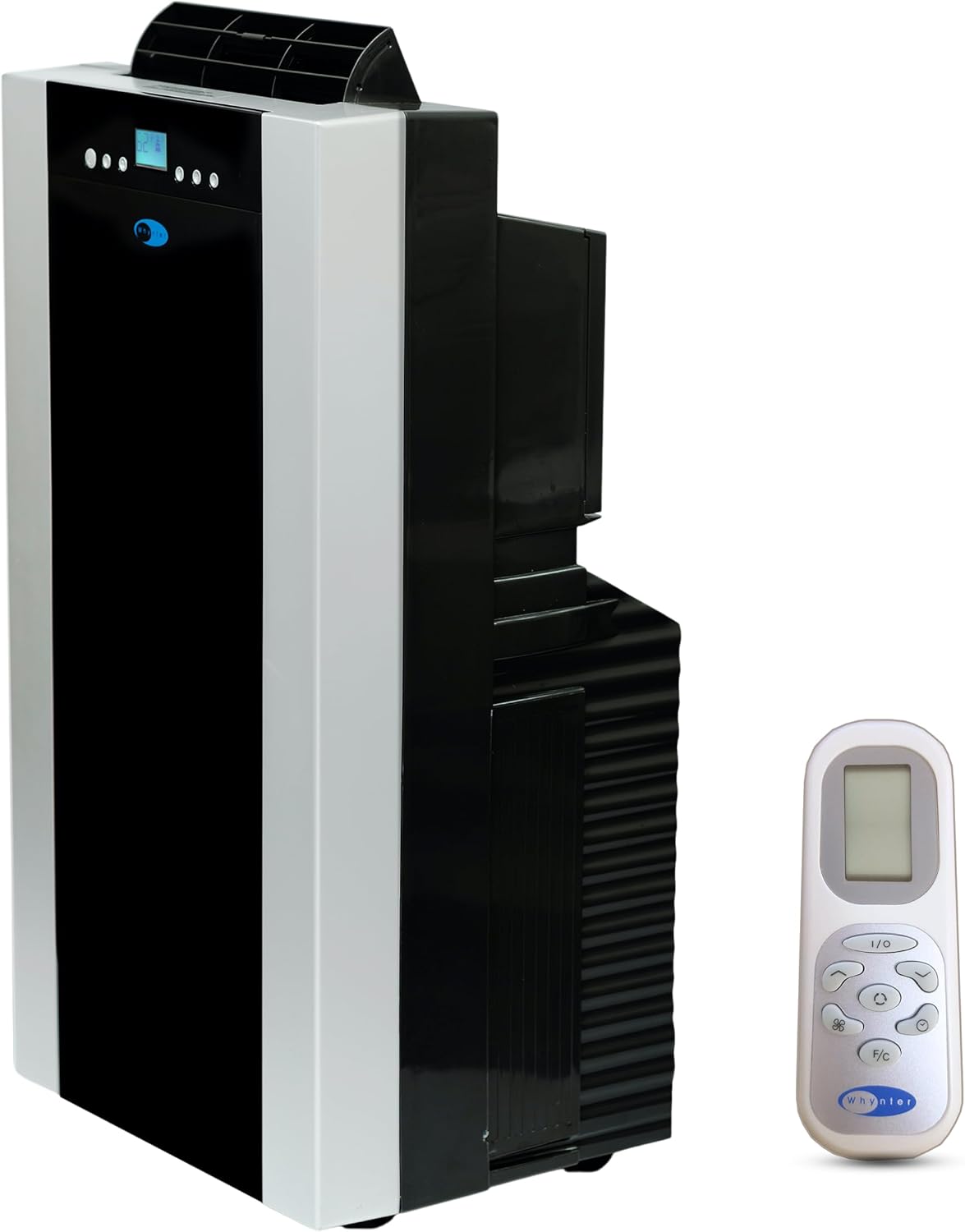
✅ Why We Recommend It: The Whynter ARC-14S is one of the most powerful and energy-efficient portable ACs on the market. With a dual-hose system, it cools much faster and more efficiently than single-hose models, making it perfect for large rooms or spaces up to 500 sq. ft.
Key Features:
- BTU Rating: 14,000 BTU (Effective cooling for large rooms)
- Cooling Area: Up to 500 sq. ft.
- Dual-Hose Design: Allows faster cooling and less energy waste compared to single-hose models.
- Energy Efficiency: High EER rating of 11.2, making it one of the most energy-efficient options available.
- Dehumidifier Mode: Removes 71 pints of moisture per day, ideal for humid climates.
- Noise Level: 56 dB (Moderate noise, quieter than most high-power models).
- Auto-Evaporation System: Minimal need for draining excess water.
- Eco-Friendly: Uses CFC-free R-32 refrigerant, reducing environmental impact.
Pros & Cons:
✅ Pros:
✔ Fast and efficient cooling, even for larger rooms.
✔ Dual-hose system prevents heat leakage, maximizing efficiency.
✔ Good energy savings compared to similar models.
✔ Dehumidifier function helps reduce humidity in hot climates.
❌ Cons:
✘ Slightly bulky and heavy (weighs about 80 lbs).
✘ Premium price – More expensive than basic models.
#2. Black+Decker BPACT08WT – Best Budget-Friendly Option
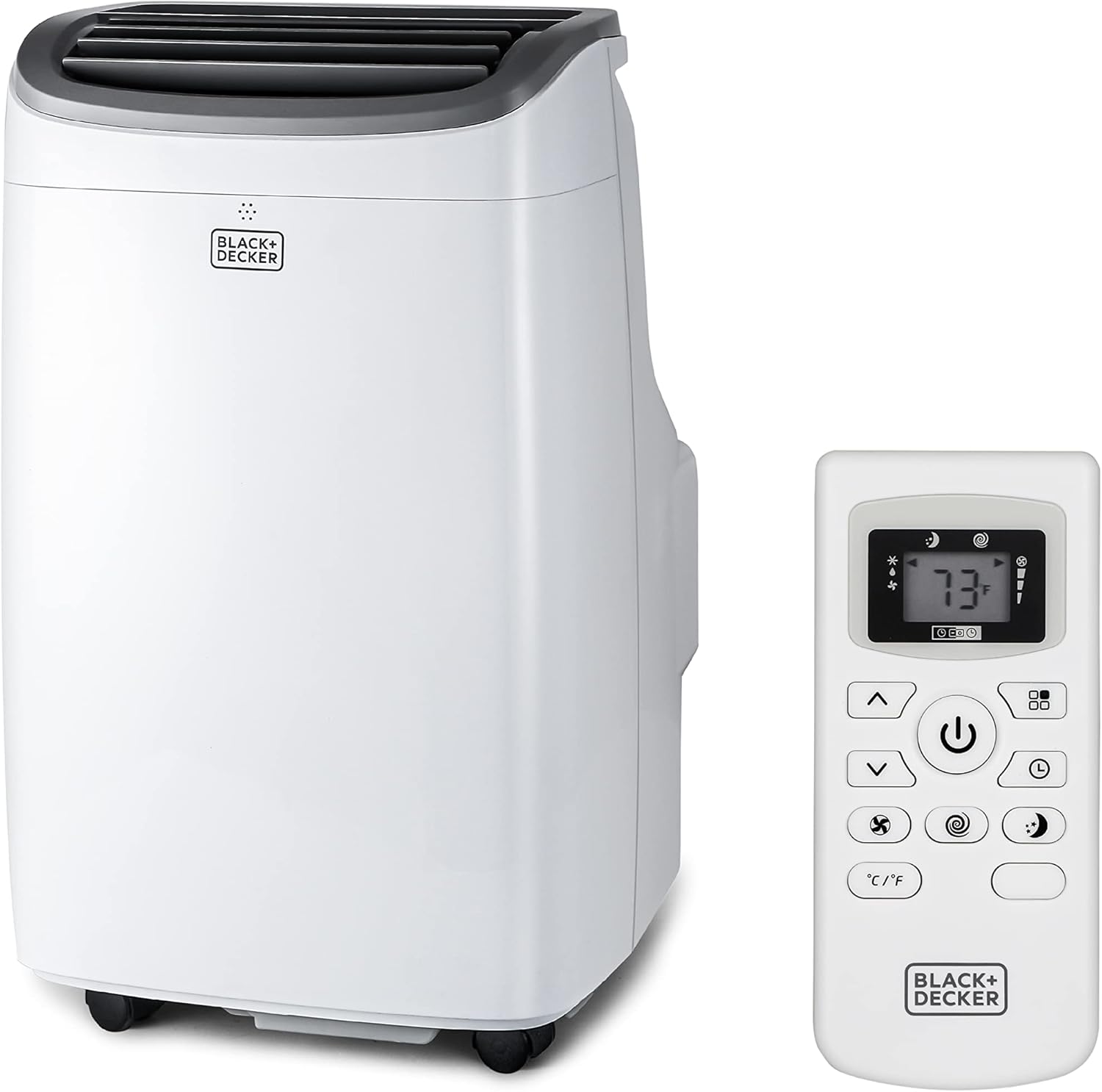
✅ Why We Recommend It: The Black+Decker BPACT08WT is an affordable and compact portable AC designed for smaller rooms up to 250 sq. ft. It is ideal for bedrooms, offices, or dorms, where you need cooling without spending too much.
Key Features:
- BTU Rating: 8,000 BTU
- Cooling Area: Up to 200-250 sq. ft.
- Single-Hose Design: Simple installation and space-saving.
- Energy Efficiency: EER rating of 8.9 – decent for a budget model.
- Noise Level: 52 dB (quiet operation, good for bedrooms).
- Fan & Dehumidifier Mode: Works as a fan or dehumidifier when cooling isn’t needed.
- Compact Design: Weighs only 52 lbs, making it one of the lightest models available.
Pros & Cons:
✅ Pros:
✔ Affordable price – great value for money.
✔ Compact & lightweight, easy to move between rooms.
✔ Quiet operation, perfect for night use.
✔ Simple installation – ideal for apartments and rental homes.
❌ Cons:
✘ Not powerful enough for larger rooms or open spaces.
✘ Single-hose design is less efficient than dual-hose models.
#3. Honeywell HF0CESVWK6 – Best Smart Portable AC
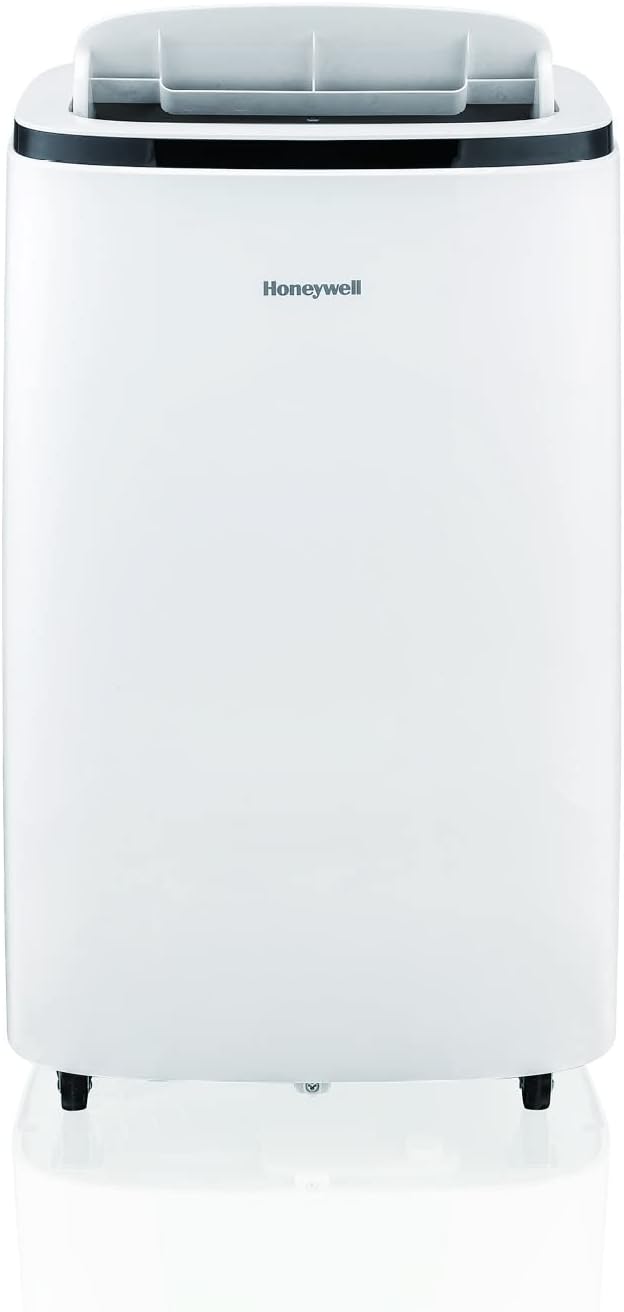
✅ Why We Recommend It: The Honeywell HF0CESVWK6 is an advanced smart portable AC with Wi-Fi connectivity, allowing you to control it remotely via a smartphone app. It’s ideal for modern homes, tech-savvy users, and smart home integration.
Key Features:
- BTU Rating: 12,000 BTU
- Cooling Area: Up to 400 sq. ft.
- Wi-Fi Smart Control: Adjust temperature, set timers, and control modes from anywhere using a mobile app.
- Energy Efficiency: EER rating of 10.4 – better than many models in its category.
- Dehumidifier Mode: Removes 80 pints of moisture per day.
- Noise Level: 54 dB, quiet enough for home and office use.
- Auto-Evaporation System: No manual draining required in most conditions.
- Alexa & Google Assistant Compatible: Use voice commands for hands-free operation.
Pros & Cons:
✅ Pros:
✔ Smart features allow remote control & automation.
✔ Decent energy efficiency, reducing electricity costs.
✔ Quiet enough for home office & bedroom use.
✔ Stylish design, fits modern interiors.
❌ Cons:
✘ Slightly more expensive than non-smart models.
✘ Wi-Fi setup can be tricky for non-tech users.
#4. Midea MAP14HS1TBL – Best Energy-Efficient Portable AC
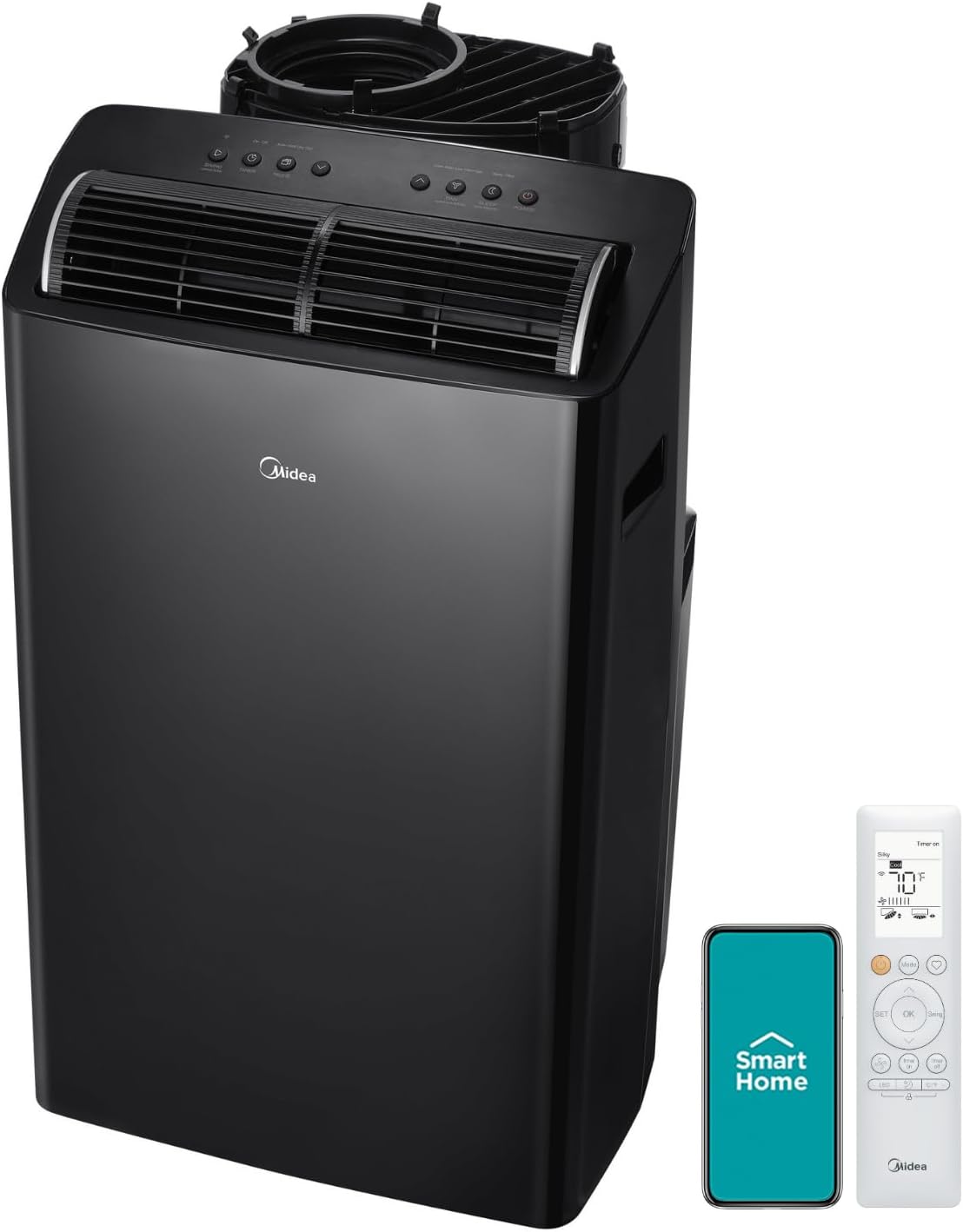
✅ Why We Recommend It: The Midea MAP14HS1TBL is one of the most energy-efficient portable ACs, featuring a high EER rating of 11.5 and Inverter Technology to reduce energy consumption.
Key Features:
- BTU Rating: 14,000 BTU
- Cooling Area: Up to 500 sq. ft.
- Inverter Technology: Adjusts power dynamically to reduce energy consumption.
- Energy Efficiency: EER rating of 11.5, one of the best on the market.
- Noise Level: 49 dB, making it one of the quietest portable ACs.
- Remote Control & Smart Features: Wi-Fi-enabled with smartphone compatibility.
- Auto Mode: Adjusts cooling speed based on room temperature for optimized energy savings.
Pros & Cons:
✅ Pros:
✔ Best energy efficiency in its category.
✔ Ultra-quiet operation – ideal for bedrooms.
✔ Powerful 14,000 BTU cooling capacity.
✔ Smart features & auto-adjust mode.
❌ Cons:
✘ Premium price point.
✘ Slightly larger than other models.
Which Portable AC Should You Buy?
| Model | Best For | Pros | Cons |
|---|---|---|---|
| Whynter ARC-14S | Best Overall | Dual-hose efficiency, strong cooling | Slightly bulky, premium price |
| Black+Decker BPACT08WT | Best Budget Option | Affordable, compact, quiet | Less powerful, single-hose design |
| Honeywell HF0CESVWK6 | Best Smart AC | Wi-Fi control, Alexa/Google Assistant | More expensive, Wi-Fi setup required |
| Midea MAP14HS1TBL | Most Energy-Efficient | Inverter tech, ultra-quiet, high EER | Expensive, larger size |
Each of these portable ACs excels in different categories, ensuring there’s an option that fits your specific needs, budget, and home setup.
FAQ: Frequently Asked Questions About Portable Air Conditioners
Conclusion: Is a Portable Air Conditioner the Right Choice for You?
Portable air conditioners are a flexible, convenient cooling option, especially for renters, small apartments, and spaces where permanent AC installation isn’t possible. While they may not be as efficient as window or central air units, they offer ease of use, mobility, and simple installation, making them ideal for temporary or supplemental cooling needs.
Key Takeaways:
- Portable ACs provide effective cooling but are less efficient than window units due to heat exhaust limitations.
- BTU rating matters – choosing the right size for your room ensures proper cooling.
- Single-hose models are less efficient than dual-hose models, which offer faster cooling and better energy efficiency.
- Modern features like smart controls, auto-evaporation, and dehumidifiers can enhance performance and convenience.
- Energy consumption is higher than window ACs, but models with high EER ratings or inverter technology can help reduce electricity costs.
Final Verdict: Should You Buy a Portable AC?
✅ YES, if you:
- Need a temporary, mobile, or easy-to-install AC.
- Live in an apartment, rental unit, or dorm where window ACs aren’t allowed.
- Want a supplemental cooling solution for a specific room.
❌ NO, if you:
- Need the most energy-efficient option for a large space.
- Want a permanent cooling solution (window AC or mini-split is better).
- Can tolerate some installation hassle for better performance (window ACs are generally superior).
Final Recommendation
If efficiency and cost savings are your top priorities, a window AC or ductless system is a better investment. However, if convenience and mobility are your main concerns, a portable air conditioner is a solid choice—especially if you select a high-quality, energy-efficient model like the Whynter ARC-14S or Midea MAP14HS1TBL.
